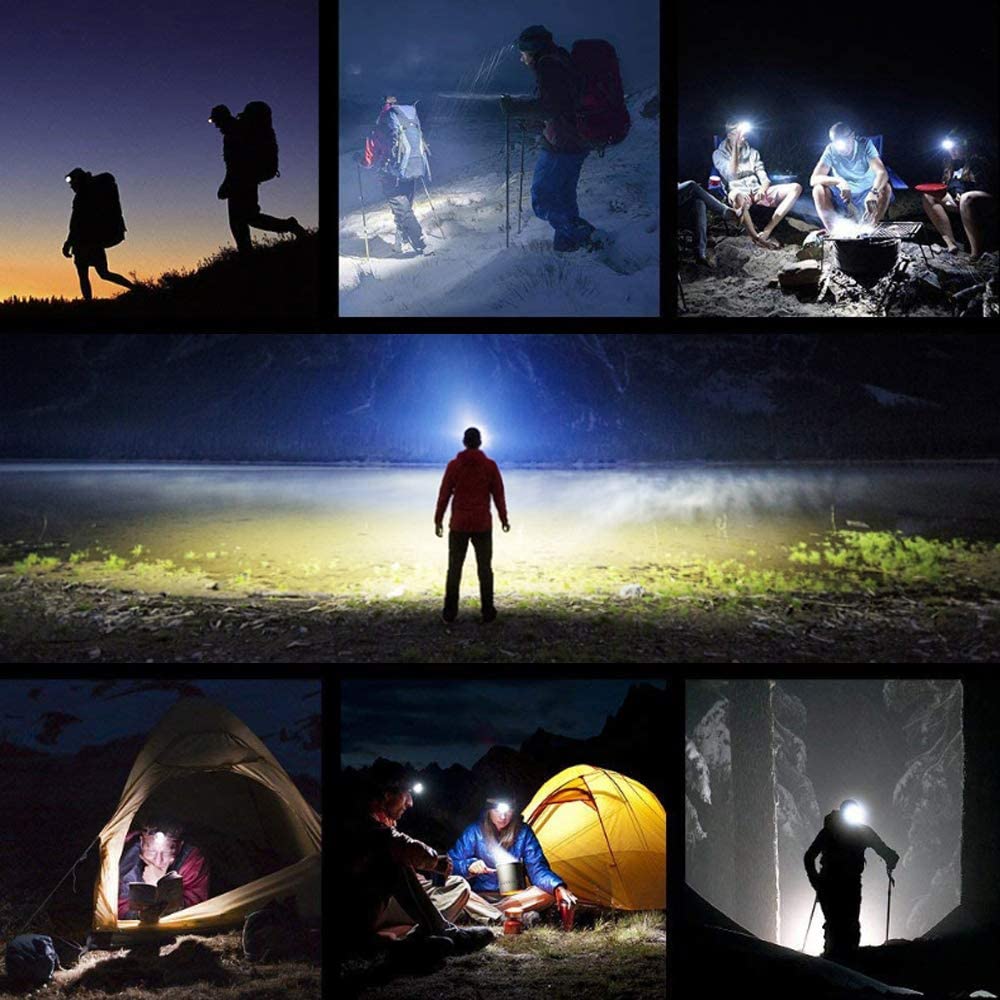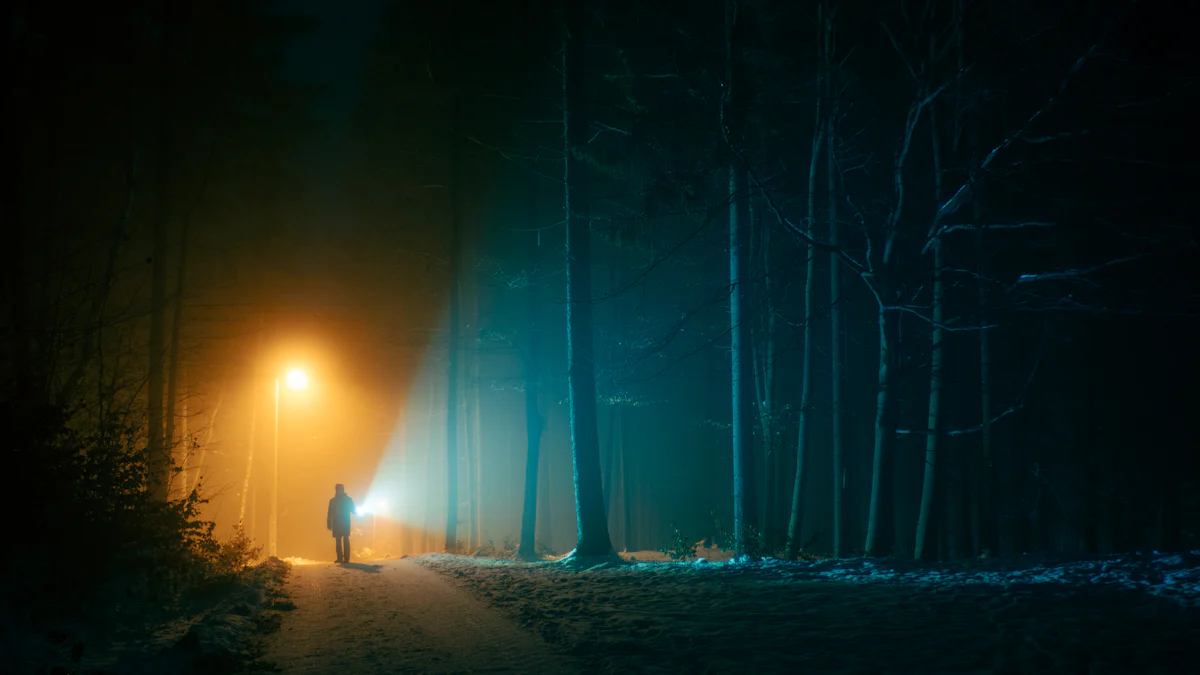Understanding Flashlight Brightness (Lumens) and Beam Distance

Flashlight lumens measure the total light output of a flashlight, directly influencing its brightness. However, more lumens don’t always mean better performance. High-lumen flashlights can drain batteries quickly or overwhelm in tight spaces. Beam distance, another critical factor, determines how far the light travels, complementing the role of flashlight brightness.
Key Takeaways
Lumens show how much light a flashlight gives off. More lumens mean brighter light but use up batteries faster.
Beam distance shows how far the light reaches before fading. A focused beam can shine farther than a wide beam, even with fewer lumens.
Picking the right lumens is important. For daily tasks, 150-300 lumens work well. Outdoor trips might need 400-1000 lumens to see clearly.
What Are Flashlight Lumens and Why Do They Matter?
Definition and Importance of Flashlight Lumens
Flashlight lumens measure the total light output of a flashlight, giving you a clear idea of how much brightness it can produce. This measurement is crucial because it directly impacts the flashlight's performance in various settings. Unlike candela, which measures the intensity of light in a specific direction, lumens focus on the overall quantity of light emitted. For example, two flashlights with the same lumen rating can have different beam distances depending on their candela ratings. Understanding the difference between lumens and candela helps you choose a flashlight that meets your specific needs.
Manufacturers test lumens by measuring the light output 30 seconds to 2 minutes after turning the flashlight on. Some companies, like Surefire, use integrating spheres to ensure accurate results. However, others may report inflated numbers based on initial outputs rather than steady-state performance. Knowing how lumens are measured ensures you can trust the flashlight's specifications.
How Lumens Determine Flashlight Brightness
The brightness of a flashlight depends heavily on its lumen rating. Higher lumens mean more light output, which translates to greater visibility. For instance, flashlights with high lumen output are ideal for tasks like search and rescue, where you need to illuminate large areas or see long distances. However, more lumens don't always mean better performance. A flashlight with excessive brightness can overwhelm your vision in confined spaces or drain the battery quickly. Balancing lumens with your intended use ensures optimal performance.
Common Lumen Ranges for Different Uses
Flashlights come in various lumen ranges tailored to specific activities. For everyday use, models with 150 to 1000 lumens are sufficient. Outdoor enthusiasts often prefer flashlights with 200 to 400 lumens for hiking or 500 to 1000 lumens for camping. Professional-grade flashlights typically range from 800 to over 3000 lumens, offering the power needed for demanding tasks. For recreational use, a flashlight with 100 to 400 lumens provides a good balance of brightness and energy efficiency. Choosing the right lumen range ensures your flashlight performs effectively in its intended environment.
Understanding Beam Distance and Its Role

What Beam Distance Means for Flashlight Performance
Beam distance measures how far a flashlight's light travels before its brightness diminishes to the equivalent of moonlight on a clear night (0.25 lux). This metric, expressed in meters, plays a critical role in determining a flashlight's effectiveness in various scenarios. For instance, a flashlight with a beam distance over 200 meters is ideal for activities like hunting, fishing, or emergency rescue. The strongest portable beam flashlights often excel in these situations, providing reliable illumination over vast distances.
How Beam Distance Complements Flashlight Lumens
Beam distance and lumens work together to define a flashlight's overall performance. While lumens measure total light output, beam distance focuses on how far that light reaches. A flashlight with fewer lumens but a tightly focused beam can illuminate farther than one with higher lumens but a wider beam. For example, the Weltool W4 Pro, with just 550 lumens, achieves a beam distance of 3351 meters. In contrast, the Acebeam X75, despite its 80,000 lumens, only reaches 889 meters. Adjustable focus further enhances usability, allowing you to switch between a wide floodlight and a narrow spotlight depending on your needs.
Lumens | Distance |
|---|---|
1–250 | Up to 80 meters |
160–400 | Up to 100 meters |
400–1000 | Up to 200 meters |
1000–30000 | Up to 350 meters |
3000–70000 | Up to 500 meters |
7000–15000 | Up to 700 meters |
Factors That Influence Beam Distance
Several factors significantly impact beam distance. The size of the reflector is crucial; larger reflectors allow light to travel farther. The LED die size and the type of TIR optic also play a role. Narrower optics, such as those with a 10-degree width, produce longer beam distances compared to wider optics. Beam divergence, or how much the beam spreads, further affects performance. Additionally, the type of light source matters. LEP flashlights, for example, can achieve greater beam distances than LED flashlights, even with similar dimensions. These elements collectively determine how effectively a flashlight projects light over long distances.
How Many Lumens Do I Need for a Flashlight?
Everyday Use: Ideal Lumen Range
For daily tasks, you don’t need excessive brightness. A flashlight with a lumen range of 150 to 300 is sufficient for activities like finding items in dark spaces or walking at night. These flashlights provide enough light for close-range visibility without draining the battery quickly. If you prefer a more versatile option, consider models with adjustable brightness settings. This feature allows you to switch between low and high lumens depending on your needs. Compact designs are also ideal for everyday use, as they fit easily into your pocket or bag.
Outdoor Activities: Choosing the Right Brightness
Outdoor adventures demand a flashlight with a higher lumen output. For hiking or camping, a recommended lumen range of 400 to 1000 ensures you can navigate trails or illuminate campsites effectively. If you’re hunting or fishing, opt for flashlights with beam distances over 200 meters. These models often combine high lumens with focused beams, providing excellent visibility in wide-open spaces. Rechargeable batteries are a practical choice for outdoor use, as they reduce the need for replacements during extended trips.
Tactical Flashlight Needs: High-Performance Options
A tactical flashlight requires advanced features to handle demanding situations. Models with 1000 to 3000 lumens are ideal for law enforcement, military, or self-defense situations. These flashlights deliver intense brightness, ensuring you can inspect large areas or disorient an attacker with a strobe function. Look for durable materials like aluminum and compact designs for easy carry. A beam distance of at least 100 meters is essential for tactical use. Adjustable brightness levels and a straightforward user interface enhance usability in high-pressure scenarios.
Factors to Consider Beyond Flashlight Brightness
Battery Life and Power Source
Battery life plays a crucial role in a flashlight's overall performance. Higher brightness levels often drain batteries faster, which can limit the flashlight's run time. To address this, you should consider models with adjustable brightness settings. These allow you to conserve power when full light output isn’t necessary. For example, using a lower setting while reading or walking can significantly extend battery life. LED flashlights are particularly energy-efficient, offering up to 75% better efficiency compared to traditional incandescent bulbs. This efficiency ensures brighter light output without compromising battery longevity, making LEDs an excellent choice for everyday use.
When evaluating power sources, rechargeable batteries provide a cost-effective and eco-friendly option. They reduce the need for frequent replacements, which is especially beneficial for outdoor enthusiasts or those relying on flashlights for personal safety. However, disposable batteries may still be preferable in emergencies due to their longer shelf life.
Durability and Weather Resistance
Durability is one of the most important factors to consider when selecting a flashlight, especially for outdoor or tactical use. Materials like aluminum alloy and stainless steel enhance a flashlight's ability to withstand harsh conditions. Aluminum alloy is lightweight and offers excellent heat conduction, while stainless steel provides high tensile strength and corrosion resistance. For premium flashlights, titanium is a top choice due to its superior strength-to-weight ratio. Budget-friendly options often use ABS or plastic polymers, which balance durability and cost-effectiveness.
Weather resistance is equally vital for maintaining performance in challenging environments. Look for flashlights with an IPX rating, which indicates protection against water and dust. An IPX7 rating, for instance, ensures the flashlight can survive immersion in water for up to 30 minutes, making it suitable for rainy or wet conditions.
Beam Type: Flood vs. Spot
The beam type significantly impacts a flashlight's visibility and suitability for specific tasks. Flood beams provide wide, dispersed light, making them ideal for short to medium-range illumination. In contrast, spot beams offer narrow, focused light for long-range visibility. The table below highlights the key differences:
Feature | Spot Beam | Flood Beam |
|---|---|---|
Beam Angle | Less than 45 degrees | More than 60 degrees |
Light Spread | Narrow and focused | Wide and dispersed |
Intensity | High intensity over a small area | Lower intensity over a larger area |
Ideal Use | Long-range visibility | Short to medium-range illumination |
For search-and-rescue operations, a combination of beam types may be necessary. High-intensity, narrow-beam lights excel at pinpointing distant objects, while flood beams illuminate larger areas. The choice depends on terrain, weather, and the operation's duration. Understanding these differences ensures you select the right beam type for your needs, whether for self-defense, outdoor activities, or professional use.
Understanding flashlight lumens and beam distance helps you select the right tool for your needs. Matching features to scenarios ensures optimal performance.
Scenario | Recommended Lumens | Purpose |
|---|---|---|
Outdoor Activities | Navigate dark trails, set up camp, and perform tasks like cooking. | |
Hiking/Backpacking | 200-400 lumens | Adequate brightness for trail navigation while being lightweight. |
Emergency Preparedness | 100-300 lumens | Long-lasting illumination for navigating dark spaces during outages. |
To choose effectively:
Everyday Carry (EDC): Compact for daily tasks.
Tactical: Durable for demanding situations.
Outdoor: Rugged and waterproof.
Headlamps: Hands-free for hiking.
Search and Rescue: High lumens for extreme conditions.
Specialty: UV lights or lanterns.
Don’t overlook factors like intended use, environment, and personal preferences. Balancing brightness, comfort, and durability ensures a flashlight that meets your expectations.
FAQ
What is the difference between lumens and beam distance?
Lumens measure the total light output, while beam distance indicates how far the light travels before dimming to moonlight brightness (0.25 lux). Both metrics define flashlight performance.
How do I choose between flood and spot beams?
Flood beams provide wide, dispersed light for close-range tasks. Spot beams focus light narrowly for long-range visibility. Select based on your activity, such as hiking or search-and-rescue.
💡 Tip: Some flashlights offer adjustable beams, letting you switch between flood and spot modes for versatility.
Are rechargeable batteries better than disposable ones?
Rechargeable batteries save money and reduce waste. However, disposable batteries offer longer shelf life, making them ideal for emergencies or infrequent use. Choose based on your usage frequency.
See Also
A Complete Guide To Understanding Flashlight Lumens
Exploring 1000 Lumens: The Brightness You Need To Know
Defining What A Tactical Flashlight Truly Means
